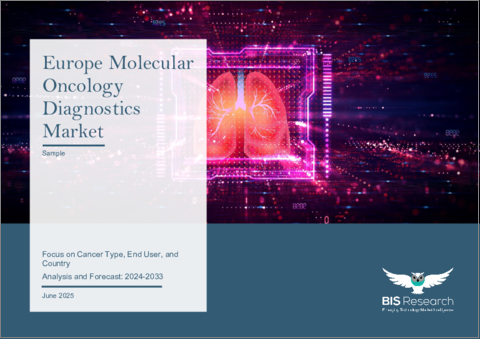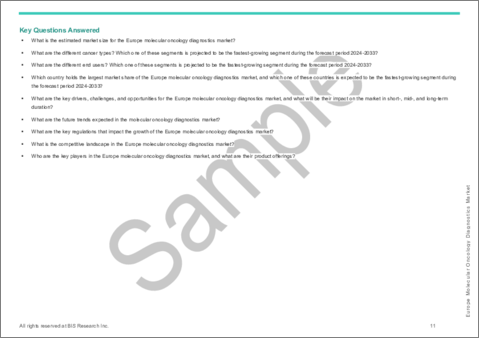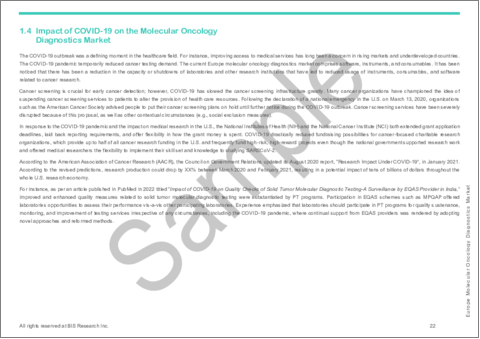|
|
市場調査レポート
商品コード
1752091
欧州の分子腫瘍診断市場:がんタイプ・エンドユーザー・国別の分析・予測 (2024~2033年)Europe Molecular Oncology Diagnostics Market: Focus on Cancer Type, End User, and Country - Analysis and Forecast, 2024-2033 |
||||||
カスタマイズ可能
|
|||||||
| 欧州の分子腫瘍診断市場:がんタイプ・エンドユーザー・国別の分析・予測 (2024~2033年) |
|
出版日: 2025年06月19日
発行: BIS Research
ページ情報: 英文 89 Pages
納期: 1~5営業日
|
全表示
- 概要
- 図表
- 目次
欧州の分子腫瘍診断の市場規模は、2024年の6億600万米ドルから、CAGR 10.78%で推移し、2033年には15億2,340万米ドルに達すると予測されています。
次世代シーケンシング (NGS)、デジタルPCR、リキッドバイオプシーなどは、欧州の分子腫瘍診断市場の拡大を牽引する技術的進歩の一部です。同地域のがん罹患率の上昇も成長要因の一つです。より良い患者の転帰、より正確な治療の選択、早期発見がこれらの進歩によって可能になります。
| 主要市場統計 | |
|---|---|
| 予測期間 | 2024-2033年 |
| 2024年評価 | 6億600万米ドル |
| 2033年予測 | 15億2,340万米ドル |
| CAGR | 10.78% |
しかし、分子腫瘍診断市場への普及には、いくつかの地域的な障壁が存在します。特に中東欧諸国では医療予算が限られているため、分子診断検査の高コストが依然として大きな課題となっています。加えて、高度な診断機器の操作や複雑なゲノムデータの解釈を行える専門人材の不足も、臨床現場での広範な活用を妨げる要因となっています。
こうした課題にもかかわらず、欧州市場は着実に成長を続けています。バイオテクノロジー企業、製薬会社、診断機器メーカー、学術研究機関が連携することで、分子ツールのがん治療への統合が進み、イノベーションも加速しています。欧州各国の医療システムにおいて分子診断の可能性を最大限に引き出すには、検査費用の引き下げ、支払い制度の標準化、医師のゲノムリテラシー向上などの取り組みが必要です。
市場の分類:
セグメンテーション1:がんタイプ別
- 固形がん
- 血液悪性腫瘍
セグメンテーション化2:エンドユーザー別
- 病院および診断センター
- リファレンスラボ
- 製薬・バイオテクノロジー企業
- 学術・研究機関
セグメンテーション3:地域別
- 欧州:英国、ドイツ、フランス、イタリア、スペイン、その他
当レポートでは、欧州の分子腫瘍診断の市場を調査し、主要動向、市場影響因子の分析、法規制環境、技術・特許の分析、市場規模の推移・予測、各種区分・地域/主要国別の詳細分析、競合情勢、主要企業のプロファイルなどをまとめています。
目次
エグゼクティブサマリー
範囲と定義
第1章 欧州の分子腫瘍診断市場:業界展望
- 世界のがんの発生率と有病率 (がんタイプ別)
- 欧州
- 動向:現状と将来への影響評価
- 企業間の提携の強化
- 分子腫瘍診断エコシステムにおける革新的な製品の発売と規制承認の増加
- 規制状況
- 欧州における法的要件と枠組み
- COVID-19による分子腫瘍診断市場への影響
- 液体生検に基づくがん分子診断
- 臨床検査 (LDT) と体外診断 (IVD)
- 分子腫瘍診断市場におけるコンパニオン診断の役割
- 市場力学
- 市場促進要因
- 市場の課題
- 市場機会
第2章 分子腫瘍診断市場:地域別
- 地域サマリー
- 促進要因と抑制要因
- 欧州
- 地域概要
- 市場成長の原動力
- 市場課題
- がんタイプ別
- エンドユーザー別
- ドイツ
- フランス
- 英国
- イタリア
- スペイン
- その他
第3章 分子腫瘍診断市場:競合ベンチマーキングと企業プロファイル
- 主要な戦略開発
- 提携・協力・事業拡大
- 新しいサービス
- M&A
- 規制および法的活動
- 企業シェア分析
- 企業プロファイル
- Biocartis Group NV
- bioMerieux
- F. Hoffmann-La Roche Ltd.
- QIAGEN N.V.
第4章 調査手法
List of Figures
- Figure 1 Europe Molecular Oncology Diagnostics Market, $Million, 2024, 2028, and 2033
- Figure 2 Molecular Oncology Diagnostics Market (by Region), $Million, 2023, 2027, and 2033
- Figure 3 Europe Molecular Oncology Diagnostics Market (by Cancer Type), $Million, 2023, 2027, and 2033
- Figure 4 Europe Molecular Oncology Diagnostics Market (by End User), $Million, 2023, 2027, and 2033
- Figure 5 Role of Diagnostics in Healthcare
- Figure 6 Cancer Prevalence and Incidence (by Cancer Type), in Million, Europe, 2022
- Figure 7 Europe In-Vitro Diagnostic Devices Regulation Regulatory Process
- Figure 8 Technological Advances in Liquid Biopsy Analysis
- Figure 9 List of Some Liquid Biopsy-Based Available Tests Approved by FDA/CE-IVD
- Figure 10 Prominent FDA-Approved Companion Diagnostics
- Figure 11 Impact Analysis of Market Navigating Factors, 2022-2033
- Figure 12 Global Distribution of Cases and Deaths (by Cancer Type), 2022
- Figure 13 Global Incidence for Cancer Types, 2018-2022
- Figure 14 Germany Molecular Oncology Diagnostics Market, $Million, 2023-2033
- Figure 15 France Molecular Oncology Diagnostics Market, $Million, 2023-2033
- Figure 16 U.K. Molecular Oncology Diagnostics Market, $Million, 2023-2033
- Figure 17 Italy Molecular Oncology Diagnostics Market, $Million, 2023-2033
- Figure 18 Spain Molecular Oncology Diagnostics Market, $Million, 2023-2033
- Figure 19 Rest-of-Europe Molecular Oncology Diagnostics Market, $Million, 2023-2033
- Figure 20 Partnerships, Alliances, and Business Expansions, January 2021-July 2024
- Figure 21 New Offerings, January 2021-July 2024
- Figure 22 Mergers and Acquisitions, January 2021-July 2024
- Figure 23 Regulatory and Legal Activities, January 2021-July 2024
- Figure 24 Data Triangulation
- Figure 25 Top-Down and Bottom-Up Approach
- Figure 26 Assumptions and Limitations
List of Tables
- Table 1: Market Snapshot
- Table 2: Key Trends, Impact Analysis
- Table 3: Molecular Oncology Diagnostics Market, Partnerships and Collaborations
- Table 4: Molecular Oncology Diagnostics Market, Product Launches and Regulatory Approvals
- Table 5: Molecular Oncology Diagnostics Market, New Offerings
- Table 6: Biomarkers for Different Cancer Types
- Table 7: Significance of Different Biomarkers in Clinical Outcomes of Various Cancer
- Table 8: Cost of Liquid Biopsy-Based NGS Kits
- Table 9: Europe Molecular Oncology Diagnostics Market, Reimbursement and Medical Coverage
- Table 10: Molecular Oncology Diagnostics Market (by Region), $Million, 2023-2033
- Table 11: Europe Molecular Oncology Diagnostics Market (by Cancer Type), $Million, 2023-2033
- Table 12: Europe Molecular Oncology Diagnostics Market, Cancer Type (by Solid Tumors), $Million, 2023-2033
- Table 13: Europe Molecular Oncology Diagnostics Market, Cancer Type (by Hematological Malignancies), $Million, 2023-2033
- Table 14: Europe Molecular Oncology Diagnostics Market (by End User), $Million, 2023-2033
- Table 15: Germany Molecular Oncology Diagnostics Market (by Cancer Type), $Million, 2023-2033
- Table 16: Germany Molecular Oncology Diagnostics Market, Cancer Type (by Solid Tumors), $Million, 2023-2033
- Table 17: Germany Molecular Oncology Diagnostics Market, Cancer Type (by Hematological Malignancies), $Million, 2023-2033
- Table 18: Germany Molecular Oncology Diagnostics Market (by End User), $Million, 2023-2033
- Table 19: France Molecular Oncology Diagnostics Market (by Cancer Type), $Million, 2023-2033
- Table 20: France Molecular Oncology Diagnostics Market, Cancer Type (by Solid Tumors), $Million, 2023-2033
- Table 21: France Molecular Oncology Diagnostics Market, Cancer Type (by Hematological Malignancies), $Million, 2023-2033
- Table 22: France Molecular Oncology Diagnostics Market (by End User), $Million, 2023-2033
- Table 23: U.K. Molecular Oncology Diagnostics Market (by Cancer Type), $Million, 2023-2033
- Table 24: U.K. Molecular Oncology Diagnostics Market, Cancer Type (by Solid Tumors), $Million, 2023-2033
- Table 25: U.K. Molecular Oncology Diagnostics Market, Cancer Type (by Hematological Malignancies), $Million, 2023-2033
- Table 26: U.K. Molecular Oncology Diagnostics Market (by End User), $Million, 2023-2033
- Table 27: Italy Molecular Oncology Diagnostics Market (by Cancer Type), $Million, 2023-2033
- Table 28: Italy Molecular Oncology Diagnostics Market, Cancer Type (by Solid Tumors), $Million, 2023-2033
- Table 29: Italy Molecular Oncology Diagnostics Market, Cancer Type (by Hematological Malignancies), $Million, 2023-2033
- Table 30: Italy Molecular Oncology Diagnostics Market (by End User), $Million, 2023-2033
- Table 31: Spain Molecular Oncology Diagnostics Market (by Cancer Type), $Million, 2023-2033
- Table 32: Spain Molecular Oncology Diagnostics Market, Cancer Type (by Solid Tumors), $Million, 2023-2033
- Table 33: Spain Molecular Oncology Diagnostics Market, Cancer Type (by Hematological Malignancies), $Million, 2023-2033
- Table 34: Spain Molecular Oncology Diagnostics Market (by End User), $Million, 2023-2033
- Table 35: Rest-of-Europe Molecular Oncology Diagnostics Market (by Cancer Type), $Million, 2023-2033
- Table 36: Rest-of-Europe Molecular Oncology Diagnostics Market, Cancer Type (by Solid Tumors), $Million, 2023-2033
- Table 37: Rest-of-Europe Molecular Oncology Diagnostics Market, Cancer Type (by Hematological Malignancies), $Million, 2023-2033
- Table 38: Rest-of-Europe Molecular Oncology Diagnostics Market (by End User), $Million, 2023-2033
- Table 39: Europe Molecular Oncology Diagnostics Market, Company Share Analysis, 2023
This report can be delivered in 2 working days.
Introduction to Europe Molecular Oncology Diagnostics Market
The Europe molecular oncology diagnostics market was valued at $606.0 million in 2024, and the market is expected to grow with a CAGR of 10.78% and reach $1,523.4 million by 2033. Next-generation sequencing (NGS), digital PCR, and liquid biopsy are just a few of the technological advancements driving the European molecular oncology diagnostics market's expansion. The region's rising cancer incidence is another factor. Better patient outcomes, more accurate treatment choices, and earlier detection are made possible by these advancements.
| KEY MARKET STATISTICS | |
|---|---|
| Forecast Period | 2024 - 2033 |
| 2024 Evaluation | $606.0 Million |
| 2033 Forecast | $1,523.4 Million |
| CAGR | 10.78% |
However, there are a number of regional obstacles to market penetration. The high expense of molecular diagnostic testing remains a hurdle, especially in nations with relatively limited healthcare budgets in Central and Eastern Europe. Furthermore, wider clinical usage is constrained by a lack of qualified personnel who can operate sophisticated diagnostic tools and decipher complicated genomic data.
The European market continues to grow in spite of these challenges. The integration of molecular tools into routine oncology care is being supported and innovation is being accelerated by cooperative efforts involving biotech companies, pharmaceutical companies, diagnostic producers, and academic research centres. Unlocking the full potential of molecular diagnostics in cancer management across various European healthcare systems would require efforts to standardise payment regulations, lower test prices, and increase clinician genomic literacy.
Market Introduction
The market for molecular oncology diagnostics in Europe is changing dramatically as more healthcare systems embrace precision medicine methods for treating cancer. Molecular diagnostics is becoming more and more important in detecting genetic changes connected to different types of cancer, driven by the demand for earlier detection, more precise diagnosis, and customised therapy planning. Advanced testing systems that support targeted therapies and enhance treatment outcomes are becoming more and more in demand in the region.
Adoption is accelerating in Western Europe, especially in nations like Germany, the UK, and France, because to established healthcare systems, benevolent legal environments, and rising genomic research expenditures. Central and Eastern Europe is progressively catching up, though, as initiatives are being made to standardise cancer treatment internationally and increase access to molecular diagnostics.
The market is also benefiting from the continuous integration of digital health, as oncology centres and labs use genetic data platforms to make decisions in real time. Demand in the market is also being driven by growing applications in risk stratification, treatment monitoring, and early diagnosis as well as rising awareness among physicians and patients. Europe is positioned to become a major centre for molecular oncology diagnostics, influencing the direction of customised cancer treatment in a variety of clinical settings as long as public and private health authorities keep funding innovation and capacity-building.
Market Segmentation:
Segmentation 1: by Cancer Type
- Solid Tumors
- Hematologic Malignancies
Segmentation 2: by End User
- Hospitals and Diagnostic Centers
- Reference Laboratories
- Pharmaceutical and Biotechnology Companies
- Academic and Research Institutes
Segmentation 3: by Region
- Europe - U.K., Germany, France, Italy, Spain, and Rest-of-Europe
Europe Molecular Oncology Diagnostics Market Trends, Drivers & Challenges:
Market Trends
- Expansion of Next-Generation Sequencing (NGS) Panels: Increasing use of multiplexed NGS assays for simultaneous detection of multiple oncogenic mutations, enabling broader genomic profiling.
- Growth of Liquid Biopsy Adoption: Rising preference for minimally invasive circulating tumor DNA (ctDNA) and circulating tumor cell (CTC) assays to monitor treatment response and detect early relapse.
- Integration with Immuno-Oncology: Molecular diagnostics platforms increasingly incorporate biomarkers (e.g., PD-L1, TMB) to guide immune checkpoint inhibitor therapies.
- Emergence of Companion Diagnostics: Co-development of targeted therapies and associated diagnostic tests is accelerating regulatory approvals and market uptake.
Market Drivers
- Rising Cancer Incidence & Aging Population: Europe's growing elderly demographic and higher cancer prevalence boost demand for precise diagnostic tools.
- Shift Toward Precision Medicine: Clinicians and payers favor personalized treatment plans, driving investment in molecular assays that predict therapy efficacy.
- Favorable Reimbursement Policies: Several European healthcare systems and HTA agencies are approving broader coverage for advanced genomic tests, reducing out-of-pocket costs.
- Technological Advancements & Cost Reductions: Continuous improvements in assay sensitivity, turnaround time, and economies of scale are making molecular tests more accessible.
Market Challenges
- High Test Development & Implementation Costs: Building validated panels and obtaining regulatory clearances remain expensive, limiting adoption in smaller hospitals.
- Fragmented Reimbursement Landscape: Inconsistent coverage policies across EU member states and varied HTA requirements create uncertainty for providers and manufacturers.
- Standardization & Quality Control Issues: Lack of uniform guidelines for assay validation, interpretation, and reporting can hamper cross-laboratory comparability.
- Data Privacy & Regulatory Complexity: Strict GDPR requirements and evolving IVDR regulations increase administrative burden and slow down clinical deployment.
Some of the prominent key players in this market are:
- Biocartis Group NV
- bioMerieux
- F. Hoffmann-La Roche Ltd
- QIAGEN N.V.
Table of Contents
Executive Summary
Scope and Definition
1 Europe Molecular Oncology Diagnostics Market: Industry Outlook
- 1.1 Global Incidence and Prevalence of Cancer (by Cancer Type)
- 1.1.1 Europe
- 1.2 Trends: Current and Future Impact Assessment
- 1.2.1 Increasing Partnerships among Players
- 1.2.2 Increasing Launch of Innovative Products and Regulatory Approvals in Molecular Oncology Diagnostics Ecosystem
- 1.3 Regulatory Landscape
- 1.3.1 Legal Requirements and Framework in Europe
- 1.4 Impact of COVID-19 on the Molecular Oncology Diagnostics Market
- 1.5 Liquid Biopsy-Based Cancer Molecular Diagnostics
- 1.6 Laboratory-Developed Test (LDT) vs. In-Vitro Diagnostics (IVD)
- 1.7 Role of Companion Diagnostics in the Molecular Oncology Diagnostics Market
- 1.8 Market Dynamics
- 1.8.1 Market Drivers
- 1.8.1.1 Rising Incidence of Cancer Cases
- 1.8.1.2 Rising Technological Advancements in Molecular Diagnostics
- 1.8.1.3 Growth in Biomarker Identification and Transformations in Molecular Techniques
- 1.8.1.4 Growing Demand for Personalized Medicine
- 1.8.2 Market Challenges
- 1.8.2.1 Lack of Qualified Professionals
- 1.8.2.2 High Cost of Molecular Diagnostic Kits and Assays Hindering the Adoption Rate
- 1.8.3 Market Opportunities
- 1.8.3.1 Focus on Reimbursement and Medical Coverage for Molecular Oncology Diagnostics
- 1.8.3.2 Focus on Next-Generation Ultrasensitive Molecular Diagnostics
- 1.8.3.3 Increasing Growth Opportunities for Molecular Diagnostics Companies in Emerging Economies
- 1.8.1 Market Drivers
2 Molecular Oncology Diagnostics Market: by Region
- 2.1 Regional Summary
- 2.2 Drivers and Restraints
- 2.3 Europe
- 2.3.1 Regional Overview
- 2.3.2 Driving Factors for Market Growth
- 2.3.3 Factors Challenging the Market
- 2.3.4 By Cancer Type
- 2.3.5 By End User
- 2.3.6 Germany
- 2.3.6.1 By Cancer Type
- 2.3.6.2 By End User
- 2.3.7 France
- 2.3.7.1 By Cancer Type
- 2.3.7.2 By End User
- 2.3.8 U.K.
- 2.3.8.1 By Cancer Type
- 2.3.8.2 By End User
- 2.3.9 Italy
- 2.3.9.1 By Cancer Type
- 2.3.9.2 By End User
- 2.3.10 Spain
- 2.3.10.1 By Cancer Type
- 2.3.10.2 By End User
- 2.3.11 Rest-of-Europe
- 2.3.11.1 By Cancer Type
- 2.3.11.2 By End User
3 Molecular Oncology Diagnostics Market - Competitive Benchmarking & Company Profiles
- 3.1 Key Strategic Development
- 3.1.1 Partnerships, Alliances, and Business Expansions
- 3.1.2 New Offerings
- 3.1.3 Mergers and Acquisitions
- 3.1.4 Regulatory and Legal Activities
- 3.2 Company Share Analysis
- 3.3 Company Profiles
- 3.3.1 Biocartis Group NV
- 3.3.1.1 Overview
- 3.3.1.2 Top Products
- 3.3.1.3 Top Competitors
- 3.3.1.4 Target Customers/End User
- 3.3.1.5 Key Personnel
- 3.3.1.6 Analyst View
- 3.3.2 bioMerieux
- 3.3.2.1 Overview
- 3.3.2.2 Top Products
- 3.3.2.3 Top Competitors
- 3.3.2.4 Target Customers/End User
- 3.3.2.5 Key Personnel
- 3.3.2.6 Analyst View
- 3.3.3 F. Hoffmann-La Roche Ltd.
- 3.3.3.1 Overview
- 3.3.3.2 Top Products
- 3.3.3.3 Top Competitors
- 3.3.3.4 Target Customers/End User
- 3.3.3.5 Key Personnel
- 3.3.3.6 Analyst View
- 3.3.4 QIAGEN N.V.
- 3.3.4.1 Overview
- 3.3.4.2 Top Products
- 3.3.4.3 Top Competitors
- 3.3.4.4 Target Customers/End User
- 3.3.4.5 Key Personnel
- 3.3.4.6 Analyst View
- 3.3.1 Biocartis Group NV
4 Research Methodology
- 4.1 Data Sources
- 4.1.1 Primary Data Sources
- 4.1.2 Secondary Data Sources
- 4.1.3 Data Triangulation
- 4.2 Market Estimation and Forecast





